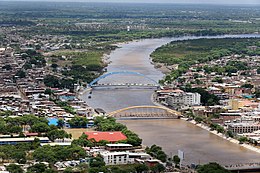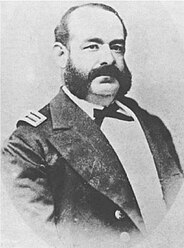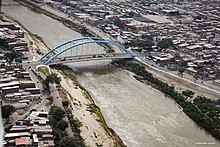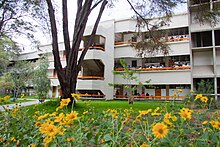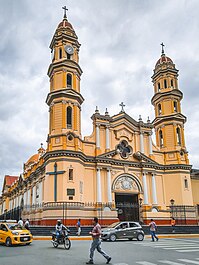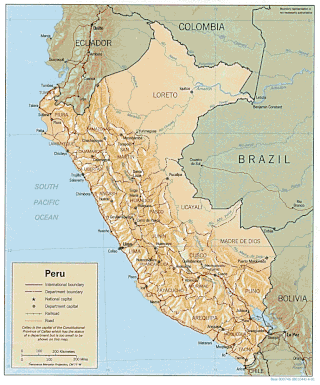
Peru is a country on the central western coast of South America facing the Pacific Ocean. It lies wholly in the Southern Hemisphere, its northernmost extreme reaching to 1.8 minutes of latitude or about 3.3 kilometres (2.1 mi) south of the equator. Peru shares land borders with Ecuador, Colombia, Brazil, Bolivia, and Chile, with its longest land border shared with Brazil.
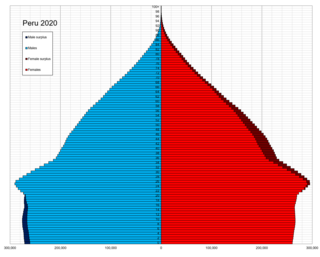
This is a demography of the population of Peru including population density, ethnicity, education level, the health of the populace, economic status, religious affiliations and other aspects of the population.

La Libertad is a department and region in northwestern Peru. Formerly it was known as the Department of La Libertad. It is bordered by the Lambayeque, Cajamarca and Amazonas regions on the north, the San Martín Region on the east, the Ancash and Huánuco regions on the south and the Pacific Ocean on the west. Its capital is Trujillo, which is the nation's third biggest city. The region's main port is Salaverry, one of Peru's largest ports. The name of the region is Spanish for "freedom" or "liberty"; it was named in honor of the Intendancy of Trujillo's proclaiming independence from Spain in 1820 and fighting for that. It is the ninth smallest department in Peru, but it is also its second-most populous department after Piura and its second-most densely populated department after Lambayeque.
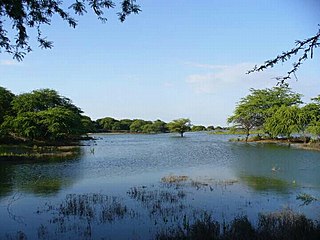
Piura is a coastal department and region in northwestern Peru. The region's capital is Piura and its largest port cities, Paita and Talara, are also among the most important in Peru. The area is known for its tropical and dry beaches. It is the most populous department in Peru, its twelfth smallest department, and its fourth-most densely populated department, after Tumbes, La Libertad, and Lambayeque.

The Sechura Desert is a coastal desert located south of the Piura Region of Peru along the Pacific Ocean coast and inland to the foothills of the Andes Mountains. Its extreme aridity is caused by the upwelling of cold coastal waters and subtropical atmospheric subsidence, but it is also subject to occasional flooding during El Niño years. In 1728, the town of Sechura was destroyed by a tsunami and was later rebuilt in its present location. In 1998, runoff from flooding rivers caused the formation of a temporary lake some 145 km (90 mi) long filling the Bayóvar Depression. Short rivers flowing across the desert from the Andes support intensive irrigation-based agriculture.

Miguel María Grau Seminario was the most renowned Peruvian naval officer and hero of the naval battle of Angamos during the War of the Pacific (1879–1884). He was known as el Caballero de los Mares for his kind and chivalrous treatment of defeated enemies and is esteemed by both Peruvians and Chileans. He is an iconic figure for the Peruvian Navy, and one of the most famous merchant marine and naval military leaders of the Americas.

Paita is a city in northwestern Peru. It is the capital of the Paita Province which is in the Piura Region. It is a leading seaport in the region. Paita is located 1,089 km northwest of the country's capital Lima, and 57 km northwest of the regional capital of Piura. Starting in 2014, the city has considered ideas for separating from the Piura Region, proclaiming itself as the "Miguel Grau Region".

Ayabaca or Ayavaca is one of the eight provinces of the Piura Region, in northwestern Peru. It borders Ecuador on the north and northeast, Huancabamba Province and Morropón Province on the south, and the Piura and Sullana provinces on the west. This province is located in the western Andes and its capital is the town of Ayabaca, which is the highest in the whole region.

Sullana is the capital of the Sullana Province, in the north-western coastal plains of Peru on the Chira valley.

Piura is a province in the Piura Region in northwestern Peru. Its capital, the city of Piura, is also the regional capital. The province is the most populous in the region as well as its center of economic activity.

Tondero is a dance and guitar rhythm from Peru that developed in the country's northern coastal region (Piura–Lambayeque).

The Sechura Province is the largest of eight provinces of the Piura Region in Peru.

A Spanish Peruvian is a Peruvian citizen of Spanish descent. Among European Peruvians, the Spanish are the largest group of immigrants to settle in the country.
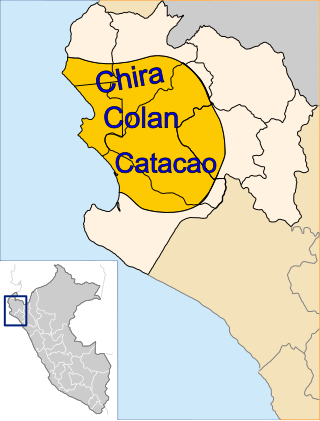
The Catacaoan languages are an extinct family of three languages spoken in the Piura Region of Peru. The three languages in the family are:

Club Atlético Grau, more commonly known as Atlético Grau or simply, Grau, is a Peruvian professional football club based in the city of Piura. The club was founded in 1919 and plays in the Peruvian Primera División, the top tier of Peruvian football. It is one of the most popular clubs in northern Peru and the Piura region along with Alianza Atlético. The clubs home ground is Estadio Miguel Grau Piura which has a capacity of 25,500. However, the club currently plays at Estadio Municipal de Bernal as Estadio Miguel Grau is being renovated.

From December 2016 and continuing until May 2017, much of western and central South America was plagued by persistent heavy rain events. In Peru, one of the most severely impacted nations, it has been referred to as the 2017 Coastal Niño. The flooding was preceded by drought-like conditions throughout the region for much of 2016 and a strong warming of sea temperatures off the coast of Peru.

The Piura River is a river in northern Peru. The river flows westward from the Andes to the Pacific Ocean and is susceptible to major flooding. Piura is the largest city along the river's course.






